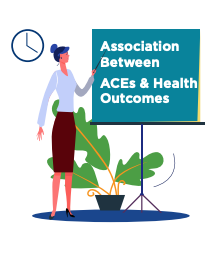Adverse Childhood Experiences (ACEs)
ACEs are disruptions to the promotion of safe, stable, and nurturing family relationships and are characterized by stressful or traumatic events that occur during an individual’s first 18 years of life.
Research consistently indicates that limiting ACEs is central to healthy child development and wellness across an individual’s lifespan.

What is an ACE score?
An ACE score is a tally of different types of abuse, neglect, and other hallmarks of a rough childhood.
A majority of Americans have at least one or more ACEs.
- Every 2 out of 3 children experience 1 or more traumatic events before turning the age of 16.
- Girls are more likely to experience traumatic events than boys, especially in the African American population.
- Socio-economically disadvantaged populations, including those with income insecure backgrounds and/or a lack of education are likely to have higher ACEs whoch often lead to negative health outcomes.
ACEs Categories

Household Challenges
- Domestic Violence: A family member is being pushed, grabbed, slapped, kicked bitten, hit with a fist, or threatened with a gun or knife.
- Substance Use: A household member misuses alcohol or uses street drugs.
- Mental Illness: A household member is depressed, mentally ill, or has attempted suicide.
- Parental Separation or Divorce: The child has lost a biological parent through divorce, abandonment, or another reason.
- Incarceration: A household member has gone to prison.
Abuse
- Emotional Abuse: The child is frequently sworn at, insulted, put down, humiliated, or made fearful of being physically hurt.
- Physical Abuse: An adult living in the household frequently pushes, grabs, slaps, or throws things at the child, or hits them to the point of injury.
- Sexual Abuse: A person at least 5 years older than the child touches or fondles the child in a sexual manner, or attempts to have, or has, sexual intercourse with the child.
Neglect
- Emotional Neglect: The child's feelings are ignored, or their family does not look out for each other, make them feel close, or supported.
- Physical Neglect: The child does not have enough to eat, has to wear dirty clothes, and has no one to take them to the doctor if needed. An adult is too under the influence to care for the child.
Association Between ACEs & Health Outcomes

Undermining
A child’s sense of safety and stability and exacerbating levels of toxic stress can harm aspects of the nervous, endocrine, and immune systems and lead to disrupted neurodevelopment across the lifespan.
Susceptibility to Mental Health Challenges
Childhood trauma and household challenges correlate with lifetime depression, anxiety, and post-traumatic stress disorder. Approximately 2/3 of suicide attempts are attributable to exposure to forms of trauma encompassed in ACEs.
Disruption and Absence of Intervention
Lead to social, emotional, and cognitive impairment, and the adoption of health risk behaviors (e.g. smoking, drug use, disordered eating, unsafe sexual behaviors – often adopted as coping mechanisms).
Likelihood for Diminished Life Opportunities
Socio-economic indicators (e.g. educational attainment, employment, and income) are often interconnected and serve as determinants to subsequent life opportunities, which impact a person’s health and quality of life.
Clinical Approach
Incorporating ACEs into risk assessments and treatment plans can catalyze access to intervention services and wraparound treatment for children and families.
Regularly screening for early adversities allows clinicians to work with children and families to address any immediate threats, and provide referrals to appropriate services.
Utilizing trauma-informed approaches to acknowledge the impact of trauma, recognize its symptoms, respond to its effects, and work towards preventing further traumatization.
Determining the most effective treatment modality will undoubtedly be a personalized and varied process for each child but ultimately should provide individuals with the tools to lead healthy, productive, and fulfilling lives.
ACEs are a prominent public health issue due to their shortand long-term ramifications on health, wellbeing, and life potential, all amounting to estimated hundreds of billions of dollars in economic and social costs each year.
